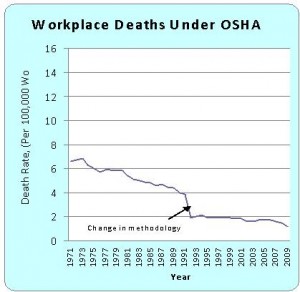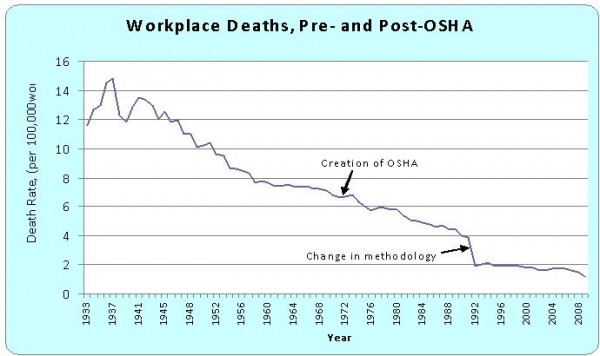Even though I’m a fiscal policy economist, I often get hit with questions on other topics. This frequently happens when I’m overseas and I’m put in the position of defending every nuance of free market policy.
I don’t mind pontificating on other issues, but I get frustrated with myself for sometimes not having the specific knowledge to make the best possible case. I was recently asked, for instance, whether the private sector was capable of protecting the health and safety of workers.
I knew enough to discuss the overall cost of regulation, the amount of valuable time diverted to comply with red tape, and some of the research on regulation and job creation.
Moreover, I made the generic argument about how employers have a profit-maximizing incentive to protect the health and safety of their workforce.
But when the person asserted to me that the creation of the Occupational Safety and Health Administration (OSHA) was followed by safer workplaces, all I could do was mumble something about the sun doesn’t rise because roosters crow and that we would need hypotheticals and counterfactuals.
Fortunately, I work at the Cato Institute where there are experts about almost every policy issue, so I was able to track down some analysis about OSHA in the Cato Handbook for Congress.
 This then led me to the National Safety Council, where I discovered that the person who was asking me about regulation was correct. As seen in this chart, workplace deaths have fallen significantly since OSHA was created.
This then led me to the National Safety Council, where I discovered that the person who was asking me about regulation was correct. As seen in this chart, workplace deaths have fallen significantly since OSHA was created.
There is a discontinuity in the data in 1992 because of a change in methodology, but I’ll stipulate that this doesn’t weaken in any way the argument that the creation of OSHA was followed by lower death rates in the workplace.
But it also turns out that my cop-out response about roosters and sunrises was right on the mark.
Let’s now look at the same chart, but this time we will include data going all the way back to 1933. What we find is that the workplace deaths were falling before OSHA and they continued to fall after OSHA.
 Now for some caveats. This chart doesn’t prove OSHA is completely ineffective. Moreover, I”m sure there were state-based workplace regulations in effect in the pre-OSHA era, and I assume the federal government also had some health and safety regulations as well, perhaps through the Labor Department.
Now for some caveats. This chart doesn’t prove OSHA is completely ineffective. Moreover, I”m sure there were state-based workplace regulations in effect in the pre-OSHA era, and I assume the federal government also had some health and safety regulations as well, perhaps through the Labor Department.
My argument is simply the more limited hypothesis that regulations impose considerable costs, which should be taken into account, and that businesses have a profit-maximizing incentive to promote health and safety in the workplace, which is increasingly important as society becomes richer.
So let me put the onus back on the pro-regulation crowd. Given the charts above, shouldn’t there be some sort of obligation to show that regulation has had a positive impact, particularly when costs are added to the equation.
And don’t give me a lazy argument about “even if we save just one life,” because I’ve already shown that a heavy regulatory burden can have a deadly impact.

